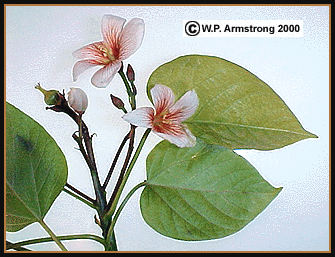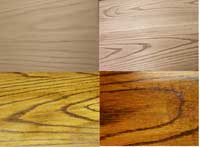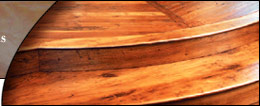


|
Tung Oil FinishesReturn to Hand Rubbed Finishes Home Page
Providing all the desired qualities of a finish, the oil's of an unassuming nut penetrate through the surface of wood, bonding within the cellular structures to form a protective barrier.
The bond becomes permanent without loosing flexibility, unlike many modern finishes this elastic nature allow a piece to expand, twist, and contract without shattering the bond of the finish - causing the well known flaking and peeling found throughout the mass production furniture industries. Along with penetration and flexibility, tung oil dries, or cures, on the surface of wood. Other oils attempting the same, linseed, olive, danish, etc never truly dry and although they provide some color and protection form the elements they act as dust magnets always having a damp feel to the surface.
Finish Comparisons: Waterlox vs. Urethane - Waterlox forms a protective finish that won't chip, peel, crack or wrinkle. Waterlox never requires sanding for adhesion purposes. So touch ups can be done at any time without sanding down to the bare wood. Waterlox vs. Raw Tung Oil and Danish Oil - Waterlox dries better and forms a film that's strong enough to walk on. Waterlox is also waterproof, while raw tung oil and danish oil will water spot. Waterlox vs. Linseed Oil - Waterlox provides deeper penetration to seal wood fibers beneath the surface. Waterlox is waterproof and will not water spot like linseed oil. Waterlox vs. Shellac - Shellac is the standard finish on Early American furniture, providing a penetrating seal and flexible finish that can be polished and refreshed for touch ups or revitalization However shellac is easily damaged by water or alcohol. True Early American antiques must be restored in almost exclusively shellac to maintain their full value. However, the rules for reproductions and collectable furniture restoration are far more flexible allowing a tung oil finish option to provide a functional alternative to shellac often applied over a two thin coats of dewaxed shellac to maintain the distinct finish appearance. Draft Format Article on Tung Oil Padding Techniques, we're developing this article to present some of our finishing practices. Check back soon for updates with photo illustrations! The Padding Technique There is an old saying that says there is more then one way to skin a cat; ergo the methods one uses in the application of tung oil varnish vary from artist to artist. Brushing, rubbing, padding, even spraying are all appropriate in various scenarios. Padding is an old time eighteenth century European technique thought to be developed in France in the early eighteenth century. We at Artisans of the Valley are formally trained eighteenth furniture makers and finishers, so the "old time techniques" prevail in our shop. We use the padding method to apply all our oil finishes, especially Waterlox a high-grade tung oil varnish. Padding is far superior to contemporary methods. The pad leaves no brush marks, only a thin film that dries in half the time of a brushed finish. Multiple thin layers build an antique satin luster, a finish almost lost to antiquity in modern mass production. The result is a finish exhibiting the characteristics of a well-preserved antique, a finish character that serves our trademark. Here's how you do it. Preparation is a key factor; sand, or better yet scrape, the wood surface as you normally would before finishing. Stain the piece, if required, and then apply a sealer. Waterlox offers a sealer finisher, or try a 1lb cut of shellac, preferably dewaxed. Two thin coats serve to seal the piece and raise the grain of the wood as it's exposed to the solvents in the sealer. Application at this phase is usually bushed on, as the grain of many woods will catch the tiny fibers of a cotton pad as they rise. Sanding with 220 grit paper or 000 grade steal wool will level the grain and remove any dust or imperfections settling in the finish as it dries. Why shellac? There are several reasons to use shellac. First it dries in 20 minutes at nominal humidity, however do not attempt to apply this sealer with above average humidity or it or it will turn white. With shellac, you can get your seal coats on in about an hour, while oil sealers take 24 hours to dry. This is a significant time savings when floor space is a premium or deadlines are looming. Shellac also raises the grain better, penetrating the wood pores deeper better then oil sealers, which do not raise grain. Deep penetration and higher rise in the grain results in more sanding; but here is the kicker, shellac takes to wood like no other substance. It is a processed natural substance, a secretion of the tropical lac bug, an aphid like insect that sucks the sap from trees and excretes it; forming piles at the base of the trees. This wonderful product of nature being digested tree sap is what makes it so compatible with wood fibers. It was the finish of choice in the eighteenth century and if you want to make a real looking antique reproduction you had better use shellac. You can apply another two coats and be done with your finishing or you can use a tung oil varnish to finish. Why finish with tung oil varnish? Shellac has one major drawback; it is not waterproof or alcohol resistant, alcohol being its solvent. In today's modern world contact with these liquids is a daily occurrence. Finishing with tung oil varnish creates a durable and easy to repair finish. Tung oil does not change the appearance of the shellac antique look, and Waterlox's formula dries very well over shellac. Many formulations forced by the EPA air pollution standards act do not allow tung oils and varnishes to properly cure over a shellac sealer. The application of tung oil over shellac is simple. Use one of the commercial stain application pads or even an old lint free tee shirt will do nicely. Apply a liberal amount to the pad and wipe on in a circular pattern working the finish into any remaining open grain and spreading it evenly. Then sweep the entire surface in nice straight overlapping strokes, applying a light downward pressure until the surface is covered. Now hears the trick of the trade. With a hard downward pressure in straight over lapping strokes wipe it off. Makes no since you say. But it does. The trick to a good finish is thin layers. The thinner the better; you will need three to six coats depending on the density of the wood. The thin coats will dry in six to eight hours so you can get two coats a day. Noting that a thick coat with a brush often takes a full 24 hours to cure, this is a definite advantage in time and risk of contamination from dust or other environmental factors. Let the final coat cure for the recommended 24 hours, then rub with 0000 grade steal wool between coats and you have a world-class satin finish any museum would be proud to display. You can use Waterlox gloss to save time with the amount of coats but will have to rub harder to take the gloss down for a proper antique satin. Finally apply a professional wax, such as Briwax or a microcrystalline wax. Maintenance is simple, wax twice a year. If you ever damage the finish or ware it thin. Clean off the wax, steel wool down the surface and apply one or two more thin coats of tung oil. Your finish is renewable for generations! As a side note from furniture, we'll take a quick jump to high gloss floor finish. First, skip the shellac; use an all oil process for the harsher conditions of a floor. Padding on with a stain pad, well maybe but that sounds time consuming. Try the application with a professional lint free roller, sweeping over sections of the floor at a time but allowing yourself access. The pros use a large pad that is on the end of a stick, even a sponge mop head to spread the thin layers and remove excess with each coat. Any questions see Artisans of the Valley web site. Stanley D. Saperstein Master Wood Carver and Furniture
|
|||||||||||||||||||||||||||||||||||||||||||||||
| home | company background | woodcarving & sculpture | period furniture custom built-in's | services | commissioning process museum/historical affiliations | educational services | craftsmen links sitemap | search |
||||||||||||||||||||||||||||||||||||||||||||||||
Artisans of the Valley Hand Crafted Custom Woodworking Stanley D. Saperstein Eric M. Saperstein Our studio and showrooms are open by appointment. Please call ahead so we don't miss you! (609) 637-0450 Fax (609) 637-0452 e-mail: woodworkers@artisansofthevalley.com |



 Tung Oil is nothing new, in fact is just about ancient. A favored finish for over 600 years tracing it's roots back to China and the Orient.
Tung Oil is nothing new, in fact is just about ancient. A favored finish for over 600 years tracing it's roots back to China and the Orient.
 Waterlox has been using tung oil as the ideal base in wood finishes for over 90 years. Family protected recopies for hand mixed variants of tung oil products and various dryers and solvents offer sealing, satin, and gloss finishes matched to any interior or exterior need, even marine applications.
Waterlox has been using tung oil as the ideal base in wood finishes for over 90 years. Family protected recopies for hand mixed variants of tung oil products and various dryers and solvents offer sealing, satin, and gloss finishes matched to any interior or exterior need, even marine applications.